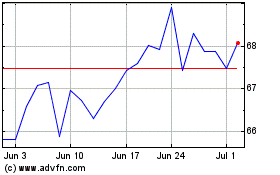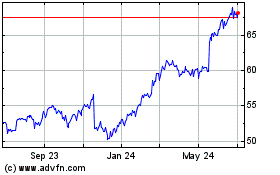By Sarah Nassauer
When the Wal-Mart Supercenter in Winnsboro, S.C., closes its
doors on Thursday after 17 years as the town's retail linchpin, a
handful of locals are hoping there could be a silver lining for the
community.
Vacant buildings that once housed a Food Lion grocery store and
Goody's department store may now find tenants, said David Stuck, a
commercial real-estate broker in Columbia, S.C., who has been
trying to fill the buildings for years.
The arrival of a Wal-Mart Supercenter in small towns often drove
out smaller stores. "Now that the big gorilla is out of the yard
maybe we will have some luck," said Mr. Stuck. "No one wanted to
compete with it."
Wal-Mart's presence in the town of about 3,500 people influenced
almost every wrinkle of local business since opening in 1998,
according to local officials, business owners and residents. It was
one of the town's biggest employers and around two-thirds of the
town's sales tax came from Wal-Mart purchases, which allowed
residents to avoid paying property tax.
The Winnsboro location is one of 154 U.S. outlets Wal-Mart
Stores Inc. will shut by Thursday, the first time the retail
behemoth has closed more than a handful of domestic stores at once.
It is a sign that Wal-Mart will slow store growth as it fights a
battle for market share against more nimble discount stores or
grocers and online behemoth Amazon.com Inc.
Most of those closing are Walmart Express stores, smaller
outlets the company started opening in 2011 to be nearer shoppers'
homes and to better compete with dollar and convenience stores. The
Winnsboro location is one of 12 Supercenters, the roughly 180,000
square-foot discount outlets that fueled Wal-Mart's growth for
decades, that are closing. Wal-Mart operates about 4,500 U.S.
stores.
When Wal-Mart opened the store in Winnsboro, it fell in line
with the company's longtime real estate strategy of opening in
rural, often overlooked areas outside of city centers. Winnsboro
sits about 30 miles north of Columbia, S.C., the largest city in
the state.
"We never planned on actually going into the cities. What we did
instead was build our stores in a ring around a city--pretty far
out--and wait for the growth to come to us. That strategy worked
practically everywhere," wrote Wal-Mart founder Sam Walton in his
1992 autobiography.
But population growth flowed east and west of Columbia, not
north to Winnsboro. "Younger people are moving to more urban areas
that have more things to offer than we have in Winnsboro," said
Roger Gaddy, a physician and Winnsboro's mayor. A Mack Trucks
factory that employed around 1,000 closed in 2002, leaving Wal-Mart
as one of the largest employers in town with 160 workers.
Wal-Mart's arrival in Winnsboro in 1998 triggered big changes in
the former cotton mill town, say residents. A Belk department store
on main thoroughfare closed later the same year.
After Wal-Mart opened on the outskirts of town, Saturday
shoppers thinned at Belk, said Anne Stephenson Broom, whose family
ran the store for 69 years. "Saturday used to be our big day," said
the 57-year-old state employee who lives in Winnsboro. "When
Wal-Mart came that was kind of the last straw."
While many local businesses struggled after the arrival of
Wal-Mart, "it actually helped our business," said John McMeekin,
owner of Winnsboro Furniture Co. until closing in 2012.
Wal-Mart "kept my customer from leaving town on their days off
to shop in Columbia," he added. Also, his store differed from
Wal-Mart by offering shoppers financing for purchases, about 85% of
the store's business. Mr. McMeekin, 61 years old, said he wanted to
retire so closed his store.
Wal-Mart headquarters in Arkansas also helped bring
manufacturing jobs to the area. Element Electronics Corp., a
television maker that counts Wal-Mart as one of its top customers,
moved workers into a former shirt factory here in 2013. A small
U.S. toy producer for Wal-Mart also moved production to the town
from China, though it recently filed for protection from
creditors.
Winnsboro is the seat of Fairfield County, whose unemployment
rate was 7.4% in December, compared with 5.3% for the state. The
county has a population that is 59% African-American, compared with
27% for the entire state.
Local residents and politicians say the Wal-Mart closure will
leave the town with one grocery store. "People are legitimately
concerned about their ability to get their needs met," said
Creighton Coleman, who grew up in town and is a state senator. "We
have elderly...these people, they can't drive 20 miles on the
interstate," to the nearest Wal-Mart, he said.
The store manager told employees of the closure two weeks ago,
said Mary Craig, a 65-year-old who started working there in 1997.
"We were all in shock. We wanted to know why," said Ms. Craig. The
manager told employees the store "wasn't making any money," she
said.
In 2015 Winnsboro's gross sales tax of $94 million fell 37%
compared with 2012, according to state tax figures. Wal-Mart
accounts for around 65% of the town's sales tax, said Mr. Gaddy,
the mayor. The 1% county sales tax is used to erase resident's
property taxes, leading to fear "that we have to reinstitute
property tax in the city," he added.
A Wal-Mart spokesman said the company considered each store's
financial performance as part of the closures, but won't comment on
specific locations. More than 75 of the Winnsboro store's 160
employees have already been assigned jobs in nearby stores and the
company is working to find jobs those who want them, the spokesman
said.
Some locals say they hope Wal-Mart's exit will leave room for
smaller businesses to thrive again. Town officials are already
soliciting grocery store companies and encouraging the few
remaining downtown businesses to stock a wider variety of products
like hunting and fishing gear, said Terry Vickers, president of the
Fairfield County Chamber of Commerce.
"Winnsboro survived before the big box came," she said, "and
Winnsboro will survive without the big box."
Write to Sarah Nassauer at sarah.nassauer@wsj.com
(END) Dow Jones Newswires
January 26, 2016 20:04 ET (01:04 GMT)
Copyright (c) 2016 Dow Jones & Company, Inc.
Walmart (NYSE:WMT)
Historical Stock Chart
From Mar 2024 to Apr 2024

Walmart (NYSE:WMT)
Historical Stock Chart
From Apr 2023 to Apr 2024
